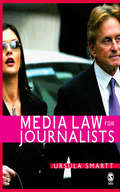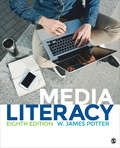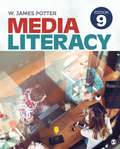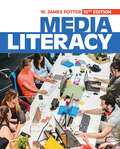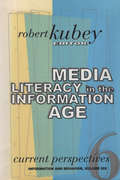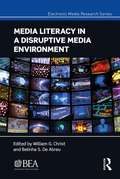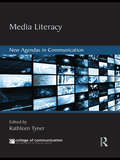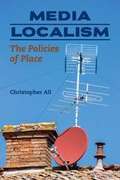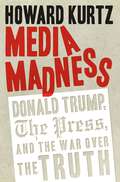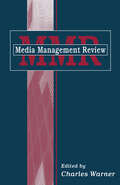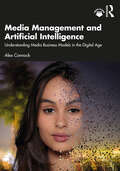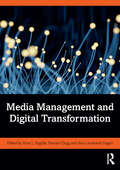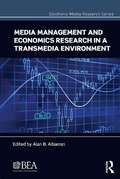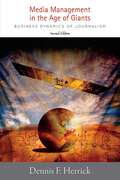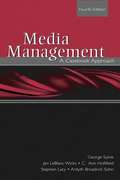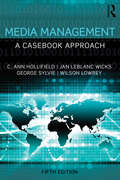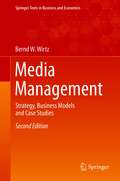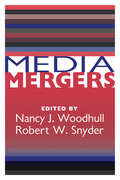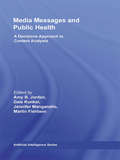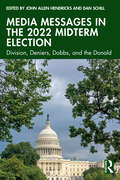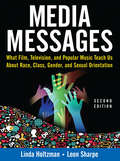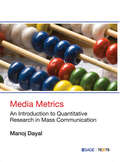- Table View
- List View
Media Law for Journalists
by Mrs Ursula Smartt'A refreshing complement to more venerable textbooks. Indeed, being both reflective and accessible, it is arguably a better first resort for aspirant hacks' Times Higher Education Supplement 'It is written in a clear and user-friendly style, avoiding the legalistic language that can be a problem with so many law textbooks. Particularly well written are the case studies that Ursula Smartt explains in each chapter' - Writing Magazine Media Law for Journalists functions as both an introduction and a reference guide to the main legal issues facing journalists. It is intended as a course textbook for students, first and foremost. However, it is also intended to help keep journalists out of jail and on the right side of the law. The book presumes no prior legal knowledge, but covers all the relevant areas including: defamation, privacy, contempt of court, freedom of expression, and intellectual property. It also looks at the difference between the English and Scottish legal systems as they pertain to the media. This book will be essential reading for all students of journalism as well a welcome guide to professional journalists.
Media Literacy
by Dr W. James PotterIn this media-saturated world, we must learn how to navigate through the overwhelming flood of information so we can avoid the risks and maximize its potential to help us. Media Literacy, Eighth Edition shows readers how. Drawing from thousands of media literature studies, bestselling author W. James Potter explores the key components to understanding the fascinating world of mass media. In this updated, revised, and reorganized new edition, Potter presents numerous examples and facts for readers to understand how the media operate, how they attract attention, and how they influence us on a day-to-day basis.
Media Literacy
by Dr W. James PotterIn this media-saturated world, we must learn how to navigate through the overwhelming flood of information so we can avoid the risks and maximize its potential to help us. Media Literacy, Eighth Edition shows readers how. Drawing from thousands of media literature studies, bestselling author W. James Potter explores the key components to understanding the fascinating world of mass media. In this updated, revised, and reorganized new edition, Potter presents numerous examples and facts for readers to understand how the media operate, how they attract attention, and how they influence us on a day-to-day basis.
Media Literacy
by Dr W. James PotterMedia Literacy teaches readers how to navigate through the overwhelming flood of information found in today’s media-saturated world. Drawing from thousands of media research studies, author W. James Potter explores the key components to understanding the fascinating world of mass media. Potter presents numerous examples and facts to help readers understand how the media operate, how they attract attention, and how they influence the public. The Ninth Edition has been thoroughly updated to evolve with the ever-changing media landscape and features a new chapter on fake news, debating what we as news consumers can do to recognize fake news in order to avoid its influence. Each chapter concludes with a set of exercises to help readers apply the chapter material to everyday life and engage in a step-by-step process to increase their own media literacy.
Media Literacy
by Dr W. James PotterMedia Literacy teaches readers how to navigate through the overwhelming flood of information found in today’s media-saturated world. Drawing from thousands of media research studies, author W. James Potter explores the key components to understanding the fascinating world of mass media. Potter presents numerous examples and facts to help readers understand how the media operate, how they attract attention, and how they influence the public. The Ninth Edition has been thoroughly updated to evolve with the ever-changing media landscape and features a new chapter on fake news, debating what we as news consumers can do to recognize fake news in order to avoid its influence. Each chapter concludes with a set of exercises to help readers apply the chapter material to everyday life and engage in a step-by-step process to increase their own media literacy.
Media Literacy
by W. James PotterMedia Literacy teaches students how to navigate through the overwhelming flood of information found in today’s media-saturated world. Drawing from thousands of media research studies, author W. James Potter explores key components to understanding the fascinating world of mass media. Potter presents examples and facts to help students understand how the media operate, how they attract attention, and how they influence the public. Chapters conclude with exercises to help readers apply the material to everyday life and improve their media literacy. The Tenth Edition integrates a stronger focus on digital media, features a streamlined organization, and updates facts to keep readers informed on the rapidly changing media phenomenon.
Media Literacy
by W. James PotterMedia Literacy teaches students how to navigate through the overwhelming flood of information found in today’s media-saturated world. Drawing from thousands of media research studies, author W. James Potter explores key components to understanding the fascinating world of mass media. Potter presents examples and facts to help students understand how the media operate, how they attract attention, and how they influence the public. Chapters conclude with exercises to help readers apply the material to everyday life and improve their media literacy. The Tenth Edition integrates a stronger focus on digital media, features a streamlined organization, and updates facts to keep readers informed on the rapidly changing media phenomenon.
Media Literacy Around the World (Information and Behavior Series)
by Robert KubeyAt the dawn of the twenty-first century, education about and through the media has become a worldwide phenomenon, and is playing an increasingly important role in educational reform. The theory and practice of media education have profited greatly from recent and intensive development and application of new information and telecommunications technologies. Consequently, the importance of media and information literacy is taking on an even greater urgency. With this in mind, the contributors to this volume survey what has taken place over the last decade in different parts of the world, examine the current state of theoretical, conceptual, and research development, and consider where media education is going and where it ought to go. With two-thirds of its 22 contributions coming from outside the United States, Media Literacy around the World is a genuine international effort, with many leading media and information educators in the world taking part. The work converts the notion of globalism from a slogan into a working hypothesis. The concerns in this volume are with literacy not just in computer technology, but as a broad concern of the educational process.
Media Literacy in a Disruptive Media Environment (Electronic Media Research Series)
by Belinha S. De Abreu William G. ChristThis book, part of the BEA Electronic Media Research Series, brings together top scholars researching media literacy and lays out the current state of the field in areas such as propaganda, news, participatory culture, representation, education, social/environmental justice, and civic engagement. The field of media literacy continues to undergo changes and challenges as audiences are reconceptualized and reconfigured, media industries are transformed and replaced, and the production of media texts is available to anyone with a smartphone. The book provides an overview of these. It offers readers specific examples and recommendations to help others as they develop their own teaching and research agendas. Media Literacy in a Disruptive Media Environment will be of great interest to scholars and graduate students studying media literacy through the lens of broadcasting, communication studies, media and cultural studies, film, and digital media studies.
Media Literacy: New Agendas in Communication (New Agendas in Communication Series)
by Kathleen TynerThis volume explores how educators can leverage student proficiency with new literacies for learning in formal and informal educational environments. It also investigates critical literacy practices that can best respond to the proliferation of new media in society. What sorts of media education are needed to deal with the rapid influx of intellectual and communication resources and how are media professionals, educational theorists, and literacy scholars helping youth understand the possibilities inherent in such an era? Offering contributions from scholars on the forefront of media literacy scholarhip, this volume provides valuable insights into the issues of literacy and the new forms of digital communication now being utilized in schools. It is required reading for media literacy scholars and students in communication, education, and media.
Media Localism: The Policies of Place (The History of Communication)
by Christopher AliWe live in a boosterish era that exhorts us to play local and buy local. But what does it mean to support local media? How should we define local media in the first place? Christopher Ali delves into our ideas about localism and their far-reaching repercussions for the discourse of federal media policy and regulation. His critique focuses on the new interest in localism among regulators in the United States, the United Kingdom, and Canada. As he shows, the many different and often contradictory meanings of localism complicate efforts to study local voices. At the same time, market factors and regulators' unwillingness to critically examine local media blunt challenges to the status quo. Ali argues that reconciling the places where we live with the spaces we inhabit will point regulators toward effective policies that strengthens local media. That new approach will again elevate local media to its rightful place as a vital part of the public good.
Media Madness: Donald Trump, the Press, and the War over the Truth (Regnery Publishing Ser.)
by Howard Kurtz"‘Defiance Disorder’: Another new book describes chaos in Trump’s White House"–Ashley Parker, Washington Post According to the media, Donald Trump could never become president. Now many are on a mission to prove he shouldn’t be president. The Trump administration and the press are at war—and as in any war, the first casualty has been truth. Bestselling author Howard Kurtz, host of Fox News’s Media Buzz and former Washington Post columnist, offers a stunning exposé of how supposedly objective journalists, alarmed by Trump’s success, have moved into the opposing camp. Kurtz’s exclusive, in-depth, behind-the-scenes interviews with reporters, anchors, and insiders within the Trump White House reveal the unprecedented hostility between the media and the president they cover.In Media Madness, you’ll learn: Why White House strategist Steve Bannon told Trump he is in danger of being impeached How the love-hate relationship between the president and Morning Joe hosts—Joe Scarborough and Mika Brzezinski—turned entirely to hate How Kellyanne Conway felt betrayed by journalists who befriended her—and how she fought backHow elite, mainstream news reporters—named and quoted—openly express their blatant contempt for Trump How Bannon tried to block short-lived Communications Director Anthony Scaramucci—and why Trump soured on himHow Ivanka and Jared Kushner aren’t the liberals the pundits want them to be—and why Trump tried to discourage them from joining the White House Why Trump believes some journalists harbor hatred for him—and how some liberals despise his voters How Trump is a far more pragmatic politician than the press often acknowledges (and how the press dismisses his flip-flops when he flops their way) What Trump got wrong about Charlottesville—and how Steve Bannon predicted the debacle How the media consistently overreached on the Russian “collusion” scandal Why Trump actually likes journalists, secretly meets with them, and allows the press unprecedented access Why Reince Priebus couldn’t do his job—and the real reason he left the White House How Sean Spicer privately berated journalists for bad reporting—and why he and Kellyanne Conway were relentlessly attacked by the mediaNever before has there been such an eye-opening, shocking look at what the White House and the media think about each other. It’s not pretty. But it also makes for the most important political book of the year.
Media Management Review
by Charles WarnerThis unique publication deals exclusively with current media management issues. It fills a void in the current literature and provides an outlet for a growing number of media scholars and practitioners interested in the ever-changing and ever-more-complex field of media management. The Media Management Review was designed to appeal to working professionals who deal directly with managing the media: radio, television, cable, newspapers, magazines, new media, and advertising agencies. Written in a style that is both understandable and applicable, this annual volume is an indispensable resource filled with information on the latest media management theories and practices.
Media Management and Artificial Intelligence: Understanding Media Business Models in the Digital Age
by Alex ConnockThis cutting-edge textbook examines contemporary media business models in the context of Artificial Intelligence (AI) and digital transformation. AI has dramatically impacted media production and distribution, from recommendation engines to synthetic humans, from video-to-text tools to natural language models. "AI is really the change agent of the media industry," answered a natural language generation model when AI was ‘asked’ about the subject of this book. "It will open incredible opportunities." This book seeks to explore them. The media is examined through four sections. ‘Principles’ maps business models and the key tools of AI. ‘Platforms’ covers distribution channels in Games, Streamers, Social Networks, Broadcast and Digital Publishing. ‘Producers’ covers the engines of content-making, including Scripted, Entertainment, Factual, Content Marketing, Creators and Music. Finally, ‘Pioneers’ covers emerging sectors of Podcasting, Esports, the Metaverse and other AI-driven developments. Then in each chapter, a standard value creation model is applied, mapping a single sector through development, production, distribution and monetisation. Diverse case studies are analysed from India, Nigeria, South Korea, South Africa, France, the Netherlands, the US, the UK, Denmark and China – around creative entrepreneurship, revenue models, profit drivers, rights and emerging AI tools. Questions are provided for each case, whilst chapter summaries cement learning. Applied and technology-focused, this text offers core reading for advanced undergraduate and postgraduates studying Media Management – or the relationship between Entertainment, Media and Technology. Online resources include chapter-by-chapter PowerPoint slides and an Instructor’s Manual with further exercises and case studies.
Media Management and Digital Transformation
by Stewart Clegg Arne L. Bygdås Aina Landsverk HagenMedia Management and Digital Transformation provides novel and empirically rich insights into the tensions, struggles and innovations of news making and managing in media organizations. <P><P> From an empirically grounded perspective this book investigates how the 'buzz' of new technology tends to prevent management from seeing which changes are needed and indeed possible to make in the newsroom. It presents ground-breaking research showing that fostering ingenious, innovative solutions can be created from within organizations by engaging and allowing employees to recognize problems, reflect and experiment with new ways of working, using technology as support for change. The research presented arises from a four-year action research project in collaboration with three small and medium-sized Norwegian newspapers, in addition to ethnographic research in newsrooms and on media organizations and phenomena in the USA and Europe. It includes among other empirical examples of newsrooms transitioning from a deadline-controlled workflow to an open-ended flowline production, and provides new tools and methods for fostering collaborative creativity and co-creative innovation practices. It also looks into newsrooms’ attempts to strengthen their audience engagement, metrics performance and external collaborations with technology providers, journalism education and action researchers. <P><P> With theoretical chapters, methodological insights and qualitative case studies of contemporary practices, this book is essential reading for students and practitioners involved with media management globally.
Media Management and Economics Research in a Transmedia Environment (Electronic Media Research Series)
by Alan B. AlbarranThis landmark work centers on media management and economics within a diverse, international, historical and constantly changing environment. The chapters herein reflect the current state of research and present directions for future study. Developed at the 2012 Research Symposium in conjunction with the annual convention of the Broadcast Education Association, it represents the most current theory and research in the area.
Media Management in the Age of Giants: Business Dynamics of Journalism, Second Edition.
by Dennis F. HerrickThe emergence of giant media corporations has created a new era in mass communications. The world of media giants—with a focus on the bottom line—makes awareness of business and financial issues critical for everyone in the industry. This timely new edition of a popular and successful textbook introduces basic business concepts, terminology, history, and management theories in the context of contemporary events. It includes up-to-date information on technology and addresses the major problem facing media companies today: How can the news regain profitability in the digital age?Focusing on newspaper, television, and radio companies, Herrick fills his book with real-life examples, interviews with media managers, and case studies. In a time when all the rules are changing because of digital technology, conglomeration, and shifting consumer habits, this text is a vital tool for students and working journalists.
Media Management: A Casebook Approach
by George Sylvie C. Ann Hollifield Leblanc Jan Wicks Stephen Lacy Broadrick Ardyth SohnMedia Management: A Casebook Approach provides a detailed look at the major areas of responsibility that fall to the managers of media organizations, including leadership, motivation, planning, marketing, and strategic management. It provides media-based cases that promote the development of critical thinking and problem-solving skills. Addressing such topics as diversity, group cultures, progressive discipline, training, and market-driven journalism, this casebook provides real-world scenarios that help students anticipate and prepare for experiences in their future careers. Among the additions to this fourth edition are Increased discussions on groups, vision, change, diversity, and management styles; Additional media-sensitive examples within each section of the text; A new chapter on knowledge management; Ethics integrated into law and leadership discussions; A primer in global markets, technology, and policy; In-depth consideration into the aspects of change; and Increased emphasis on analysis. This edition also includes management scenarios in which one or more participant is a new employee or intern, making the material relevant to students while also preparing them to understand the motivations of their future employers. Developed as a media management text for advanced undergraduates and graduate students, Media Management provides realistic scenarios and invaluable insights on working in the media industries.
Media Management: A Casebook Approach (Lea’s Communication Series)
by George Sylvie C. Ann Hollifield Wilson Lowrey Jan Leblanc WicksMedia Management: A Casebook Approach provides a detailed consideration of the manager's role in today's media organizations, highlighting critical skills and responsibilities. Using media-based cases that promote critical thinking and problem-solving, this text addresses topics of key concern to managers: diversity, group cultures, progressive discipline, training, and market-driven journalism, among others. The cases provide real-world scenarios to help students anticipate and prepare for experiences in their future careers. Accounting for major changes in the media landscape that have affected every media industry, this Fifth Edition actively engages these changes in both discussion and cases. The text considers the need for managers to constantly adapt, obtain quality information, and be entrepreneurial and flexible in the face of new situations and technologies that cannot be predicted and change rapidly in national and international settings. As a resource for students and young professionals working in media industries, Media Management offers essential insights and guidance for succeeding in contemporary media management roles.
Media Management: Strategy, Business Models and Case Studies (Springer Texts in Business and Economics)
by Bernd W. Wirtz“Digitalization significantly changes the media. To cope with this change and to exploit new market opportunities is a major challenge for media corporations. Bernd Wirtz provides a valuable guideline for this new world, combining theory, facts, and practice.” Dr. Hubert Burda, German publisher and Managing Corporate Partner of Hubert Burda Media Holding KG “The media business is subject to substantial change while differences between distinctive media areas are fading away. This is due to technical innovation in areas like transmittance of content, bearer of content and recording devices but also due to new formats, trends and constant change of consumer behavior.” The textbook “Media and Internet Management” stays abreast of changes and covers this topic on a well-founded and comprehensive basis. It makes a valuable contribution to theory and practice in media management and is highly recommendable to media managers.” Christoph Mohn, Chairman of the Supervisory Board, Bertelsmann AG “The world of media is full of challenges and dynamic conditions for its field. The dynamic of this market is accelerated even more by new digital technologies and ongoing globalization. This book is an absolute “must have” for everyone who wants to know more about the basics, conditions and requirements of modern media management. The analytical clearness and structure make this publication highly relevant for students, but also for managers.” Urs Rohner, Chairman of the Board of Directors, Credit Suisse Group AG “Media Management is a textbook, but a very welcome newcomer for students and teachers as it fills a market gap for good educational material in this rapidly evolving field. It is concise, simple (but not simplistic), and contains a contemporary overview of concepts and tools for media managers. ” Prof. Dr. Bozena I. Mierzejewska, Editor of The International Journal on Media Management, Fordham University, New York “Summed up, with his second edition Wirtz managed to strengthen the outstanding position of his publication “Media Management”. His textbook shines because of its content, analytical clearness and the high relevance for business practice without losing its academic background. With the second edition this book has established its position in the field of media business as the leading standard reference book in Germany. It is suitable for business students, lectures as well as managers who can gain magnificent information from it.” Prof. Dr. Wolfgang Fritz, Director of the Institute of Marketing, Braunschweig University of Technology, Germany; Honorary Professor at the Institute of Business Administration, University of Vienna, Austria.
Media Mergers
by Nancy J. Woodhull Robert W SnyderThe recent surge in media mergers has set off a wave of stories that all hit very close to home. In some cases, the news organizations themselves become news. The formation of communication conglomerates raises profound questions for reporters' lives and work, such as: What is the best way to cover stories of high profile and complexity? Will the new giants broaden both the definition of journalism and the opportunities for journalists to practice their craft? What are the prospects for the new partnership of big news, new media, and big business? The consequences of consolidation vary by media industry. The evolution of communication technology is so fast that today's truisms can be undone tomorrow. Media Mergers provides a healthy dose of skepticism, a search for illuminating facts, and a willingness to consider all sides of the discussion.This book approaches the emergence of media giants from a variety of angles. The contributors offer many ways of understanding their scale and their significance. Media Mergers is divided into six parts: "Point/Counterpoint," "The Imperial Moment," "Captains of Communication," "States of Media," "The Consequences of Media Empires in the United States," and "The Consequences of Media Empires Around the World." Authors include: Todd Gitlin; Steven Rattner; Ken Auletta; Madeline Rogers; Danny Schechter; Barbara Maltby; and Mac Margolis.Included in this volume is a roundtable introduced by Walter Cronkite and moderated by Alex Jones. Participants are Frank A. Bennack, Jr., Neil S. Braun, P. Anthony Ridder, and Arthur Ochs Sulzberger, Jr. A review essay by Anne Wells Branscomb concludes book. She discusses various books on the subjects of media moguls, multimedia conglomerates, and media takeovers. Media Mergers is especially pertinent today, an age in which the communications industry is constantly changing, progressing, and being affected by business upheavals. It will be of interest to publishers, media specialists, and all those in communications, policy and research.
Media Messages and Public Health: A Decisions Approach to Content Analysis
by Martin Fishbein Amy B. Jordan Dale Kunkel Jennifer ManganelloMedia Messages and Public Health addresses the full range of methodological and conceptual issues involved in content analysis research, specifically focused on public health-related messages and behaviors. Uniquely tailored to the challenges faced by content researchers interested in the study of public health topics, coverage includes: Conceptual and methodological foundations involved in the practice of content analysis research used to examine public health issues. Measurement challenges posed by the broad range of media. Use of content analysis across multiple media types. The potential for individual differences in audience interpretation of message content. Case studies that examine public health issues in the media to illustration the decisions that are made when developing content analysis studies. The volume concludes with a set of guidelines for optimal content analysis research, and suggests ways in which the field can accommodate new technologies and new ways of using media. Developed for researchers in communication, media, and public health, this unique resource demonstrates how the variety of decisions researchers make along the way allows the exploration of traditions, assumptions and implications for each varying alternative and ultimately advances the science of content analysis research.
Media Messages in the 2022 Midterm Election: Division, Deniers, Dobbs, and the Donald
by John Allen Hendricks Dan SchillThe 2022 midterms marked a transformative moment in American politics, as the combined influence of legacy media and social platforms reached new heights. Traditional outlets like television news and print journalism set the stage, while a vast digital ecosystem—spanning Facebook, TikTok, YouTube, and more—enabled campaigns to amplify messages on issues like abortion rights, the economy, and immigration. As these platforms shaped the voter experience in a fragmented and often- polarized media environment, campaigns and citizens harnessed their power to reach diverse audiences and build momentum across both established and emerging channels.This book offers a compelling, scholarly exploration of these dynamics, revealing how communication across traditional and digital media shaped an election forecasted as a Republican “red wave” but instead delivered unexpected, narrower results. Through detailed analyses, data- driven research, and case studies from high- profile races, this book uncovers how media strategies influenced voter behavior, shaped public discourse, and framed electoral outcomes. Essential for academics, political analysts, and media professionals, this work provides crucial insights into the evolving role of media in U.S. elections and the weighty implications for future democratic engagement.
Media Messages: What Film, Television, and Popular Music Teach Us About Race, Class, Gender, and Sexual Orientation
by Linda Holtzman Leon SharpeThe new edition of this widely adopted book reveals how the popular media contribute to widespread myths and misunderstanding about cultural diversity. While focused on the impact of television, feature film, and popular music, the authors reach far beyond media to explore how our understanding, values, and beliefs about race, class, gender and sexual orientation are constructed. They analyze how personal histories, combined with the collective history of oppression and liberation, contribute to stereotypes and misinformation, as well as how personal engagement with media can impact prospects for individual and social freedom. Along with updated media examples, expanded theories and analysis, this edition explores even more deeply the coverage of race in two chapters, discusses more broadly how men and boys are depicted in the media and socialized, and how class issues have become even more visible since the Great Recession of the 21st century and the Occupy movements. Special activities and exercises are provided in the book and an online Instructor's Manual is available to adopters.
Media Metrics: An Introduction to Quantitative Research in Mass Communication
by Manoj DayalThe book is a comprehensive introduction to the application of statistical tools and techniques in media research. "Media metrics" is the use of statistics and mathematics in media research. This book largely explains scientific methods of data collection and analysis to achieve useful results from quantitative media data. It effectively describes the crucial relationship between key media forces such as print and electronic media, corporate communication and public relations, advertising, development communication, web and traditional media, and so on. It guides the readers to understanding the challenges of media measurement, its quantification, datafication and assessment, and helps in developing skills of media audience analysis. Key Features Pioneering introductory text on media metrics, a method of measuring media variables Clear and easy-to-understand explanation of descriptive and inferential media variables and their use Complete coverage with relevant examples from media studies Review exercises, and extensive list of references Ideal companion for students and researchers in the fields of mass communication, media studies, communication studies, and journalism
